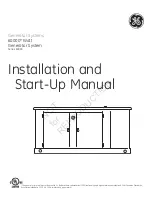
5. Connect a length of wire between the inverter’s negative (–) terminal and the DC power source negative (–) terminal.
6. Connect a short length of wire to the other terminal of the fuse holder or circuit breaker. Mark it “positive” or “+”.
7. Connect the free end of the fuse or breaker wire to the positive (+) terminal of the DC power source (battery).
8. Insert a fuse appropriate to the inverter in the fuse holder.
9. Test the inverter by turning it on and plugging in a 100 watt lamp or equipment.
10. If the inverter is not properly operating, then refer to the “Troubleshooting” section of this manual.
CAUTIONS: TO REDUCE THE RISK OF PROPERTY DAMAGE
• Loose connectors may cause overheated wires and melted insulation.
• Check to make sure you have not reversed the polarity. Damage due to reversed polarity is not covered by manufacturer’s
warranty.
IMPORTANT CABLE INFORMATION
Substantial power loss and reduced battery operating time results from inverters installed with cables that are not able to supply
full power. Symptoms of low battery power can result from cables that are either excessively long or an insufficient gauge. Marine
installations are also subjected to vibration and stresses that exceed those of other mobile installations. Therefore, the installer/
operator should be especially aware of the requirements to maintain secure, tight, water-resistant electrical connections and to
provide for strain relief for DC cables and appliance wiring. Cable insulation must be the appropriate type for the environment.
OPERATING INSTRUCTIONS
The power/fault LED indicator lights solid when the inverter is properly connected to a functioning DC power source. The AC and
USB outlets are ready to use. (If the power/fault LED indicator flashes, refer to the Troubleshooting Section of this Instruction
Manual.)
CAUTION: TO REDUCE THE RISK OF PROPERTY DAMAGE:
Always connect the inverter to the 12 volt DC power source
before
plugging any devices into the unit.
The standard North American 120 volt AC and USB outlets allow simultaneous operation of multiple devices. Simply plug the
110/120 volt AC appliance into one of the inverter’s three-prong AC outlet and/or plug the USB-powered device into the inverter’s
USB charging port and operate normally.
Notes:
Ensure that the wattage of all equipment simultaneously plugged into the inverter does not exceed 500 watts continuous.
If the inverter does not work when using the vehicle accessory outlet, make sure the ignition/accessory switch is actually powering the accessory outlet.
Some vehicles require the ignition switch to be turned on.
The inverter will not operate appliances and equipment that generate heat, such as hair dryers, electric blankets, microwave ovens and toasters.
This inverter’s USB Charging Port does not support data communication. It only provides 5 volts/500mA DC power to an external USB-powered device.
Remember to turn the unit off and disconnect from any power source when it is not in use.
CARE AND MAINTENANCE
Storage
1. Ideal-storage-temperature-range-is-0-40°C (32-104°F).
2. Store and use the inverter in a cool, dry place with adequate ventilation for all-around air circulation.
3. Avoid locations that are exposed to heating units, radiators, direct sunlight, or excessive humidity or dampness.
Fuse Replacement (in Vehicle Accessory Outlet Plug)
If the inverter is overloaded, and the green LED is not lit, the internal 8 amp fuse may be blown.
1. Unscrew the flange of the plug (counterclockwise).
2. Remove the end contact, flange and fuse.
3. Inspect the fuse to see if it is good or blown.
4. Replace with a new 8 amp fuse, if needed.
5. Carefully reassemble the fuse, end contact and flange. Do not overtighten the flange (clockwise).
TROUBLESHOOTING
Common Audio Problems
Buzzing Sound In Audio Systems
Some inexpensive stereo systems and boom boxes make a buzzing sound when operated from the inverter, because the power
supply in the electronic device does not properly filter the modified sine wave produced by the inverter. The only solution to this
problem is to use a sound system that has a higher quality power supply.
Television Interference
The inverter is shielded to minimize interference with TV signals. However, in some instances, some interference may still occur,
particularly where TV signals are weak. Try the following corrective measures:
• Place the inverter as far as possible from the television, the antenna and the antenna cables. Use an extension cable, if necessary.
• Readjust the orientation of the inverter, the antenna cables and the TV power cord to minimize interference.
COOL – Ambient air temperature should be between 30°F (–1°C) non-condensing and 105°F (40°C). Do not place the inverter on or
near a heating vent or any piece of equipment that is generating heat above room temperature. Keep the inverter out of direct
sunlight.
VENTILATED – Allow at least three inches of clearance from other objects to ensure free air circulation around the inverter. Never
place items on or over the inverter during operation.
SAFE – Do not locate inverters in an area, room or compartment where explosives or flammable fumes might be present, such as
engine rooms, engine compartments, and boats or small, unvented battery compartments.
Marine Applications
DO NOT install the inverter below or near the waterline, and keep the inverter away from moisture and water. The unit’s housing is
moisture-resistant (NOT waterproof).
ONLY install the inverter on a level, stable surface where it is not likely to fall or be knocked over; and is not subject to vibration.
Use ONLY non-corrosive marine fasteners and fittings for installation.
WARNING: TO REDUCE THE RISK OF ELECTRIC SHOCK OR PROPERTY DAMAGE
In all marine applications, always observe the directions given above, as well as those listed in the Important Safety Instructions of
this manual.
Connecting to a Power Source Using the 12 Volt DC Vehicle Adapter Plug with O-Ring Connectors
The DC Accessory Outlet Plug is suitable for operating the inverter at power outputs up to 100 watts.
1. Check to make sure the inverter’s On/Off switch has been turned off (the power/fault LED is not lit).
2. Turn the red plastic cap (counterclockwise) on the inverter’s positive (+) cable post and remove. Attach the positive O-ring at
the end of the red 12 volt DC vehicle adapter cable. Replace the cap and turn clockwise to secure. Do not over-tighten.
3. Turn the black plastic cap on the inverter’s negative (–) cable post counterclockwise and remove. Attach the negative O-ring at
the end of the black 12 volt DC vehicle adapter cable. Replace the cap and turn clockwise to secure. Do not over-tighten.
4. Connect the 12 volt DC vehicle adapter plug to a vehicle’s accessory outlet or other 12 volt DC power source. Make sure there is
adequate space for proper ventilation of the inverter.
5. Rotate the plug slightly to make sure there is good contact.
CAUTIONS
•
Connect directly to power source using the included Battery Clips when operating above 100 watts.
• Do not use with positive ground electrical systems.
• Reverse polarity connection will result in a blown fuse and may cause permanent damage to the inverter.
Note:
Most vehicle accessory outlet circuits have fuses rated at 15 to 20 amps or greater. To operate at full wattage, either use the supplied battery clips or
directly wire to the power source with wire and fuse (NOT SUPPLIED).
Connecting to a Power Source Using the Supplied Battery Clips with O-ring Connectors
Use the provided battery clips (with cables and O-ring connectors) to connect the inverter directly to the 12 volt power source as
follows:
1. Check to make sure the inverter’s On/Off switch has been turned off (the power/fault LED is not lit) and that no flammable
fumes are present in the installation area.
2. Turn the red plastic cap (counterclockwise) on the inverter’s positive (+) cable post and remove. Attach the positive connector
at the end of the red battery clip cable into the groove of the positive (+) cable post. Replace the cap and turn clockwise to
secure. Do not over-tighten.
3. Connect the red battery clip to the POSITIVE terminal of the battery.
4. Turn the black plastic cap (counterclockwise) on the inverter’s negative (–) cable post and remove. Attach the negative
connector at the end of the black battery clip cable into the groove of the negative (–) cable post. Replace the cap and turn
clockwise to secure. Do not over-tighten.
5. Connect the black battery clip to the NEGATIVE terminal of the battery.
6. Make sure that all connections between cables and terminals are secure.
Direct Hardwiring to Power Source (optional connection method; hardware not included)
Use #10 AWG wire if the inverter to power source connection is 10 feet or less. For longer cable lengths use #8 AWG wire. In either
case, protect the positive (+) wire from shorts by installing a 50 amp fuse or circuit breaker close to the DC power source (battery)
terminal.
PROCEDURE
1. Check to make sure the inverter’s On/Off switch has been turned off (the power/fault LED is not lit) and that no flammable
fumes are present in the installation area.
2. Identify the positive (+) and negative (–) DC power source (battery) terminals.
3. Install a fuse holder or breaker close to the positive (+) terminal of the DC source (battery).
4. Connect a length of wire on one side of the fuse holder or circuit breaker. Connect the other end of the wire to the positive (+)
terminal of the inverter.
6
7
PC509CA_ManualENFR_121813.indd 6-7
12/18/2013 10:49:09 AM


























